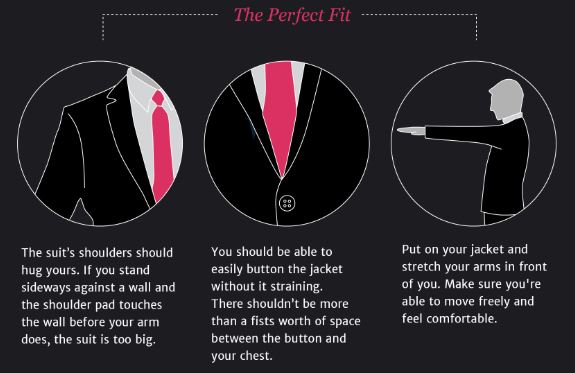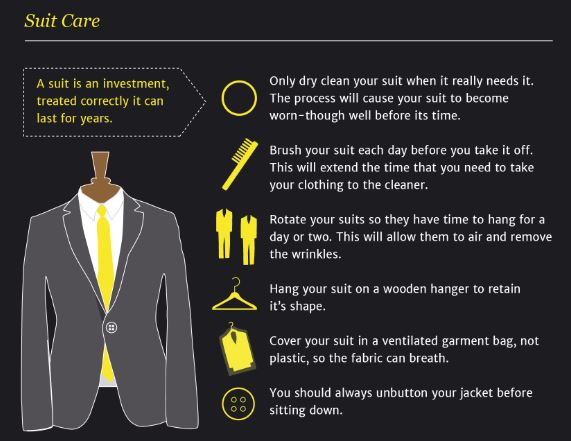It helps to know some of the correct tailoring terminology when buying that first suit and what to expect from your first fitting. We spoke to T.M Lewin to help us put together some of the most useful tips to aid you in your search for the perfectly fitting suit.
Whether it’s an interview for an internship or a graduation suit that’s memorable for all the right reasons, there’s no doubt that at some point in the not too distant future, you’ll be making your first foray into the world of men’s suits.
But do you know your ‘inseam’ from your ‘overarm shoulder’? Your ‘cutaway’ from your ‘cumberband’?
It helps to know some of the correct tailoring terminology when buying that first suit and what to expect from your first fitting. We’ve put together some of the most useful tips to aid you in your search for the perfectly fitting suit.
Know your measurements
A suit, like a pair of shoes, should fit perfectly. Would you hit the field in boots that didn’t fit? We didn’t think so. Take the time to visit a tailor and have your measurements taken. Usually, they’ll do it for free, especially if you’re going to buy one of their suits.
Then these seven main measurements should cover it.
1) Chest – Measure the largest or fullest part of your chest with the tape level and under your arms. Keep the tape snug but not tight for a comfortable fit.
2) Arm length – This is measured from your shoulder joint to your wrist bone.
3) Overarm shoulder width – Measure from the outside of one shoulder joint to the other. This determines the width of the jacket and is essential if you want to avoid the MC Hammer style.
4) Neck – Wrap the tape around your lower neck about an inch below the Adam’s apple. You should be able to fit two fingers between the tape and your neck so your new shirt won’t turn your face purple.
5) Waist – Measure around the navel area and make sure you can get a finger in there under the tape. Remember you’ll have a belt to tighten the waist too.
6) Inseam – You’ll need a friend you’re comfortable with for this one. Measure from where your leg meets your groin down to the bottom of your foot.
7) Outseam – Not essential but to cover all the bases measure from your beltline down to the bottom of your foot, on the outside of course.
Colours
You can’t go wrong with the staple of every businessman’s wardrobe, the black suit. It’s fitting for any occasion and is the easiest of colours to pair with shirts and ties but while being tried and trusted, it’s not exactly adventurous. If you’re attending your graduation this year, the grey suit is a slightly more stylish option and will look great against your black mortar board.
This season’s popular trend is blue. Swap a traditional black evening suit for midnight blue skinny for a cool contemporary look without standing out too much. What’s great about blue is that it can be teamed with a bright and bold skinny tie such as red, or kept more casual with a knitted grey tie.
The fit
This is all down to personal preference, but you may have noticed that both the slim fit suit and the skinny suit are popular choices. It really just boils down to your personal style and what you feel comfortable in but to stay ahead of the style stakes skinny is our favourite.
The details
It’s the little things that can make or break a look.
Lapels – You can choose either a peaked or a notched lapel with peaked being for more formal events and notched suitable for any occasion. For your graduation or end of year ball, go for a shawl, which continuously curves all the way to your buttons
Cuffs – Wear a dress shirt the first time you try on your suit and make sure that only half an inch of cuff is visible.
Trouser length – The hem of your trousers should rest on the top of your shoes with your socks only showing when walking or sitting.
Accessories – Cufflinks, tie bars, and pocket squares are all good but choose only two of the three. Over-accessorizing is decidedly Del Boy.
The shirt and tie
Do we need to tell you to match the fit of your shirt to the fit of your suit? It’s plain common sense that a slim fit suit needs a slim fit shirt so let’s just leave it at that.
With regards to colours, this is a matter of personal choice but we will say that whatever colour you choose you need to opt for a complementing colour of tie and pocket square – NEVER matching. Patterns are acceptable but ensure that the pattern is not repeated anywhere in your look. So best to avoid those pocket square, shirt, and tie combo packs you’ll find in the bargain bin.
You may cringe at the thought of it, but the bow tie is enjoying a bit of a renaissance and is no longer reserved for aged uncles and eccentric professors. Choosing a bow tie is a fashion-forward move that screams style but if you prefer the more traditional style, then choosing a skinny tie offers a slight twist on a typical look.
Now that you’ve been suitably schooled in the art of suiting disaster avoidance, there’s no excuse. Save your pennies and invest in a good suit, you’ll soon learn that the rewards more than justify cutting down on your monthly beer intake!
Win a T.M.Lewin suit!
We’ve teamed up with T.M.Lewin to offer one lucky reader a suit worth up to £199 – see how to enter here!



